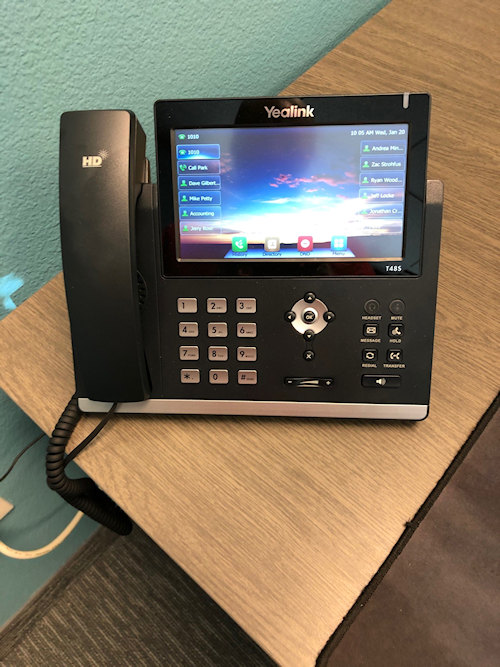
In late 2020, we learned that Communication Links would move from mid-Scottsdale to new offices in Scottsdale Airpark. We spent almost seven years on Indian Bend Road, and the time seemed exactly right to relocate to a different type of office environment for the team. We made the move in mid-January 2021.
As with any company relocation, it’s a great chance to rethink office layouts and workflow, get rid of old hoarded files and copies of golf publications dating back to, well, seemingly the turn of the century. And, as the digital dude, it was an opportunity to look at more advanced technology to run our business, with security top-of-mind.
I’m not the longest-serving member of the staff by a long-shot, but when I joined 12 years ago we were using a telephone system with a half-dozen metal boxes in the network rack room and yards and yards of copper wiring. The handsets were difficult to program, and some weren’t working as they should. And forget the voice mail system and background “hold” music option. If we needed to add a line to the system or change the programming, we had to call the phone system integrator that installed the system over 15 years ago in a prior location. We knew first-hand that “what’s old never gets new again.” It was time to flush old tech and try something different.
Enter Voice Over IP (VoIP)
VoIP (Voice Over Internet Protocol) has had a rocky road to acceptance in business due to real quality of service issues. While it’s relatively new tech, the Silicon Valley curse of “being on the bleeding edge” has led to some bad press about VoIP as a communications platform. Problems typically centered around the voice transmissions in which the signal would break up, voices would sound scratchy and hollow, and parts of the call would drop out in mid-sentence. Since the voice signal is traveling for most of its journey over the Internet rather than old-fashioned copper wire tech, the culprit is generally low bandwidth from the company’s Internet provider, lower quality handsets and low-speed routing of voice calls. If you have both a wired and wireless Internet system in your office, and you decide to bolt on telephones to the same network, you just might hit a snag. Simply, too many devices needing bandwidth at the same time. The net result is lower quality service across the entire system.
 The good news is the VoIP tech has come a long way in the last few years, but as a precaution we decided to double our “down” speed with our Internet provider for starters (from 100mbps to 200mbps). Maybe a bit over-the-top, but the incremental cost was reasonable. Second, we integrated a recognized name in office communications, GoToMeeting/GoToConnect, as our backbone software/telco cloud provider. They, in turn, provided high tech handsets that were easy to program with multiple snazzy features, and all of this is now hanging off our in-house Ethernet network and run through our switching cabinet.
The good news is the VoIP tech has come a long way in the last few years, but as a precaution we decided to double our “down” speed with our Internet provider for starters (from 100mbps to 200mbps). Maybe a bit over-the-top, but the incremental cost was reasonable. Second, we integrated a recognized name in office communications, GoToMeeting/GoToConnect, as our backbone software/telco cloud provider. They, in turn, provided high tech handsets that were easy to program with multiple snazzy features, and all of this is now hanging off our in-house Ethernet network and run through our switching cabinet.
One of the great features we offered the staff is the ability to have a call “follow me” if we are out of the office. Let’s say Jonathan Crist is “working” on the golf course by hosting an important writer thinking about doing a story on a client’s business when a call comes to his office. Sure, the call can go to vmail after “x” number of rings. Or, if more convenient, with a few simple steps Jonathan can have that call automatically redirected to his mobile phone so he never misses an important call (well, unless he’s in the middle of lining up an important putt!!).
Our phone bill is lower, the system has worked flawlessly thus far and managing our telephone system has been a breeze.
Use Streaming Services? It Was an Easy Choice.

Linear television service through a provider such as Comcast or Cox has gotten far more expensive over the last couple of years, and if you want CableTV, users are forced to buy into a tiered programming system. Unfortunately, we wind up paying huge sums for channels we’ll never watch. How bad is it in the CableTV world? Click here to read more.
Since a large part of our day-to-day work puts us in the golf business, we have to stay on top of golf programming, golf advertising and golf promotional opportunities to help tell our clients’ stories. That means that we need golf/sports-related programming beamed into our office so we can keep up with Golf Channel, ESPN and general news that may affect the industries we serve.
Rather than assume we had no other choice but to call our local CableTV provider and sign-up for expensive CableTV service in Scottsdale Airpark, we decided to cut the cord. Other members of the team at CommLinks had already done just that in their homes, me included, so making that decision was an easy one based on our needs, ease of installation and plain old economics.
Our four TVs use Hulu+LiveTV connected via Ethernet cable to our network infrastructure. We do have a few older (but still good) non-Smart TVs, so we deployed Apple’s streaming box, subscribed to Hulu and we use that app on AppleTV. Today we have outstanding service, we pay for the programming tier we want, and we have lower costs of operation.
Since we doubled our Internet connection speeds as part of our relocation, we now have faster wired and wireless speeds in the office for network access and we easily handle VoIP and streaming television services as well.
It Might Work for You as Well
As part of our relocation decisions, we also decided to centralize our distributed network attached storage services, and simplify the multiple Wi-Fi routers and patch panel/network switch set-up as well. While this is cool stuff to me, I suspect the subject might be a little dry for inclusion in this CommLinks post ?. But, if you’re interested, give me a call.
Many companies with far larger staffs and significant sunk costs in legacy systems may not be as lucky as we were. Our decision was simple: we wanted to use higher quality technology, we wanted to reduce our operational expenses and we desired easy self-management of our infrastructure. We accomplished those goals.
Hopefully, you can, too.
